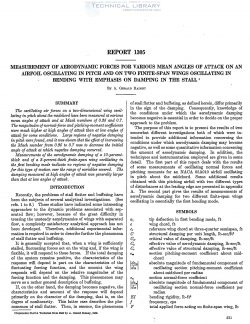naca-report-1305
- Version
- 181 Downloads
- 1.84 MB File Size
- 1 File Count
- November 2, 2016 Create Date
- November 2, 2016 Last Updated
National Advisory Committee for Aeronautics, Report - Measurement of Aerodynamic Forces for Various Mean Angles of Attack on an Airfoil Oscillating in Pitch and on Two

The oscillating air forces on a two-dimensional wing oscillating
in pitch about the midchord have been measured at various
mean angles of attack and at Mach numbers of 0.35 and 0.7.
The magnitudes of normal-force and pitching-moment coefiicients
were much higher at high angles of attack than at low angles of
attack for some conditions. Large regions of negative damping
in pitch were found, and it was shown that the eject of increasing
the Mach number from 0.35 to 0.7 was to decrease the initial
angle of attack at which negative damping occurred.
Measurements of the aerodynamic damping of a 10-percent—
thick and of a 3~percent—thick finite—span wing oscillating in
the first bending mode indicate no regions of negative damping
for this type of motion over the range of variables covered. The
damping measured at high angles of attack was generally larger
than that at low angles of attack.
Recently, the problems of stall flutter and bufl’eting have
been the subjects of several analytical investigations. (See
refs. 1 to 8.) These studies have indicated some interesting
approaches to the dynamic problems associated with sep-
arated flow; however, because of the great difficulty in
treating the unsteady aerodynamics of wings with separated
flow, a completely satisfactory analytical approach has not
been developed. Therefore, additional experimental infor-
mation is required in order to describe further the phenomena
of stall flutter and buffeting.
It is generally accepted that, when a wing is sufficiently
stalled, fluctuating forces act on the wing and, if the wing is
flexible, it will respond to these forces. If the total damping
of the system remains positive, the characteristics of the
response will depend in part on the characteristics of the
fluctuating forcing function, and the amount the wing
responds will depend on the relative magnitudes of the
forcing function and the damping. This phenomenon may
serve as a rather general description of bufieting.
If, on the other hand, the damping becomes negative, the
characteristics and amount of the response will depend
primarily on the character of the damping, that is, on the
degree of nonlinearity. This latter case describes the phe-
nomenon of stall flutter.
| File | Action |
|---|---|
| naca-report-1305 Measurement of Aerodynamic Forces for Various Mean Angles of Attack on an Airfoil Oscillating in Pitch and on Two.pdf | Download |

Comment On This Post